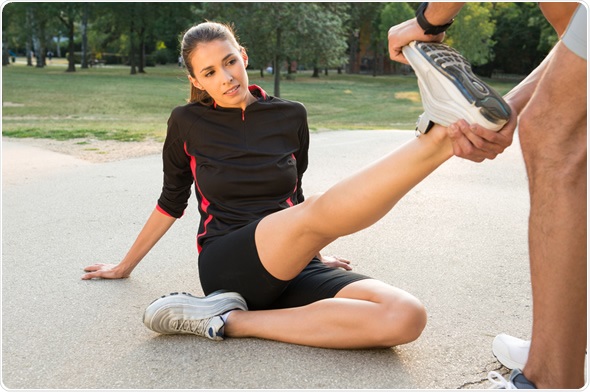It may not be necessary to prevent leg cramps if they are relatively mild and do not often occur, such that they have an insignificant impact on quality of life. However, individuals that frequently suffer from leg cramps may prefer to prevent them with a variety of methods.
Underlying Causes
Initially, it is important to consider any underlying causes that may be contributing to the leg cramps and causing them to occur more often.
For example, several medications can lead to the presentation of leg cramps as a side effect. In many cases, an alternative is available that will not have the same effects.
Additionally, certain medical conditions can increase the risk of leg cramps, and when these underlying conditions are adequately managed, the symptoms of cramp often resolve.
Dehydration is another common cause of leg cramps and rehydrating with adequate fluids and electrolytes can help to restore the balance of salts in the bloodstream and prevent cramp.
Stretching Exercises
Stretching the calf muscles in the leg may help in the management of cramps when they occur, in addition to preventing the symptoms from beginning.
Considering the widespread nature of this recommendation, there is minimal scientific evidence to support the claim. However, many individuals find it is effective in helping to prevent cramp and there is low risk in performing the exercises.

An example exercise consists of standing approximately 75cm away from a wall, depending on the height of the individual, and leaning towards the wall with feet flat on the ground, such that the calf muscles are extended. For the best results, it is best to stretch the muscles regularly, approximately three times a day, as needed.
It may take a few weeks for the benefits of the stretching to become evident, so it is recommended to continue the exercise even if no effect is noticed immediately. If there is still no improvement after four weeks, other preventative techniques may be required.
Prevention of Nocturnal Cramps
For individuals that suffer from cramp at night when they are sleeping, small changes to the sleeping position can help to prevent cramp.
These changes primarily promote the extension of the calf muscles, based on the belief that cramp may be caused by the stimulation of an already shortened muscle to contract further. To lessen the extent that to feet point downwards and shorten the calf muscles it may be helpful to:
- Prop the feet up with a pillow
- Keep blankets loose around feet
- Hang feet over end of bed while sleeping on front
Similarly to stretching exercises, there is little scientific evidence to support this preventative technique but many individuals have positive results.
Pharmacological Prevention
Quinine is a treatment available that can help in the prevention of leg cramps, although it is associated with some risks and it is important to weigh these up against the benefits. It is relatively safe and can be taken by most individuals in a single dose at nighttime to help prevent cramp.
However, when taken in high doses, quinine can have detrimental effects, particularly when taken by children. It is primarily for this reason that quinine is reserved for severe cases with frequent episodes of cramp.
There are several other possible medications that may be able to help prevent leg cramps, although these are usually less effective than quinine and viewed as alternative treatments.
References
- http://patient.info/health/Cramps-in-the-Leg
- http://www.aafp.org/afp/2012/0815/p350.html
- http://pmj.bmj.com/content/78/924/596.full
- http://www.ncbi.nlm.nih.gov/pmc/articles/PMC3445088/
Further Reading
- All Cramp Content
- What causes cramp?
Last Updated: Aug 23, 2018

Written by
Yolanda Smith
Yolanda graduated with a Bachelor of Pharmacy at the University of South Australia and has experience working in both Australia and Italy. She is passionate about how medicine, diet and lifestyle affect our health and enjoys helping people understand this. In her spare time she loves to explore the world and learn about new cultures and languages.
Source: Read Full Article